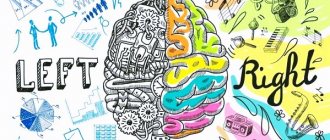Not every problem can be related to the mother. After all, there is another person involved in raising the child.
In addition, there are many other important people in a child's life who influence him. There are brothers and sisters, grandparents, aunts and uncles, godparents, close family friends, nannies, kindergarten workers, teachers, peers and others
who regularly communicate with the child.
The question posed above is tongue-in-cheek, but it touches on an important debate in psychology: what influences how children turn out the way they do? What influences their ability to form meaningful, satisfying relationships with others?
What factors contribute to their anxiety, avoidance, and satisfaction when it comes to relationships?
Important!
Psychologists can say quite convincingly that it is not entirely the mother's fault, or even the fault of both parents. However, we can be sure that a child's early experiences with his or her parents have a profound impact on his or her relationship skills as an adult.
Much of the knowledge we have on this subject today is based on a concept developed in the 1950s called attachment theory. This theory will be the focus of this article: we will look at what it is, how it describes and explains behavior, and what its position is in the real world.
Definition
The psychological theory of attachment was first described by John Bowlby, a psychoanalyst who studied the effects of separation between infants and their parents.
Bowlby hypothesized that extreme behaviors that children engage in to avoid separation from a parent or when reconnecting with a physically separated parent—like crying and screaming—were evolutionary mechanisms.
Bowlby believed that this behavior may have been reinforced by natural selection and increased the child's chances of survival.
These attachment behaviors are an instinctive response to the perceived threat of losing the survival benefits that come with being the caregiver and being cared for by the primary caregiver(s). Because children who engaged in these behaviors were more likely to survive, the instincts were naturally selected for and strengthened over generations.
Important!
These behaviors constitute what Bowlby called the “attachment behavioral system,” a system that guides us in our patterns and habits of forming and maintaining relationships.
Research on Bowlby's attachment theory found that children who find themselves in an unfamiliar situation and separated from their parents typically reunite with their parents in one of three ways:
- Secure attachment.
These children suffered from separation, but sought comfort and were easily consoled when their parents returned. - Anxiety-resistant attachment.
A minority of infants experienced greater levels of stress and, when reunited with their parents, appeared to seek comfort and try to “punish” the parents for leaving. - Avoidance of attachment.
Infants in the third category showed no or minimal distress when separated from their parents and either ignored their parents after reunification or actively avoided their parents.
In subsequent years, researchers have added a fourth attachment style to this list: the disorganized-disoriented attachment style.
, which refers to children who do not exhibit predictable patterns of attachment behavior.
Intuitively, a child's attachment style is largely a function of the care the child receives early in life. Those who have received support and love from their caregivers are likely to be secure, while those who have experienced inconsistency or neglect from their caregivers are likely to experience more anxiety regarding their relationship with their parents.
However, attachment theory goes one step further by applying what we know about attachment in children to the relationships we enter into as adults. These relationships (especially intimate or romantic relationships) are also directly linked to our childhood attachment styles and caregiving
, which we received from our primary caregivers.
The development of this theory gives us an interesting perspective on the study of child development.
Pictured is
John Bowlby
Bowlby and Ainsworth: history and psychology of attachment theory
Bowlby's interest in child development dates back to his first experience outside of college, in which he volunteered at a school for maladjusted children. According to Bowlby, two children sparked his curiosity and laid the foundation for attachment theory.
Important!
Through his work with children, Bowlby developed a strong belief in the influence of family experiences on children's emotional and behavioral well-being.
Early in his career, Bowlby suggested that psychoanalysts working with children should take a holistic approach
, taking into account the children's living environment, families and other experiences in addition to any behavior that the children themselves exhibit.
This idea has evolved into a strategy for helping children by helping their parents, given the importance of the child's relationship with the parents (or other caregivers).
Important!
Around the same time that Bowlby was laying the foundations for his attachment theory, Mary Ainsworth was finishing her graduate studies and studying security theory, which proposed that children develop a secure dependence on their parents before venturing into unfamiliar situations.
In 1950, these two paths crossed when Ainsworth took a position in Bowlby's research department.
at the Tavistock Clinic in London. Her initial responsibilities included analyzing recordings of children's behavior, which inspired her to conduct her own research on children in their natural settings.
Through several papers, numerous studies, and theories that were discarded, modified, or combined, Bowlby and Ainsworth developed and presented evidence for attachment theory. They were a more rigorous explanation and description of attachment behavior than any others on the topic at the time, including those that grew out of Freud's work and those that were developed in direct opposition to Freud's ideas.
Pictured is
John Bowlby
conclusions
Attachment development occurs early in life but has an impact throughout a person's life. In order for a child to develop harmoniously in the future, love himself and be happy in relationships with other people, it is important to form his basic trust in the world. Caring for the baby, responsiveness and emotional participation in the life of the baby, forms a reliable attachment to a loved one. This is the basis for strong and trusting relationships in the future.
Research
There have been several pioneering studies that have contributed to the development of attachment theory and provided evidence for its validity, including the study described earlier in which infants were separated from their primary caregivers and their behavior was noted to fall within an attachment "style" .
Pictured is
Harry Harlow
Harlow's experiments
In the 1950s, Harry Harlow conducted experiments on love and relationships between parents and children. His work showed that maternal love was emotional rather than physiological, and that the capacity for attachment was strongly influenced by experiences in early childhood
, and that this ability is unlikely to change much once it is "established".
Harlow discovered these interesting results by conducting two innovative experiments.
In the first experiment, Harlow separated baby monkeys from their mothers a few hours after birth. Instead, each monkey was raised by two surrogate "mothers". Both provided the monkeys with the milk they needed to survive, but one was made of chicken wire and the other was made of wire mesh covered with soft terry cloth
.
Monkeys that were given the freedom to choose which mother to associate with almost always chose to take milk from the terry cloth.
For the second experiment, Harlow changed his original setup. The monkeys were given either a bare wire surrogate mother or a terry cloth mother, both of which provided the milk needed to raise the monkeys
.
Both groups of monkeys survived and thrived physically, but they had very different behavioral tendencies. Those with terry cloth mothers returned to the surrogate when given strange, loud objects, while those with chicken wire mothers threw themselves to the floor, grabbed, rocked back and forth, or even “screamed in terror.” "
This provided a clear indication that the emotional attachment received from cuddling in infancy influenced the monkey's later stress responses and emotion regulation.
Important!
These two experiments laid the foundation for further work on attachment in children and the impact of attachment experiences later in life.
Pictured: Erika Erikson
LiveInternetLiveInternet
J. Bowlby, the founder of Attachment Theory, his follower M. Ainsworth and others (Cassidy, Crittenden, Durkin, Goldfarb, Fahlberg, Jacobsen, Kennel, Klaus, Main, Rutter, Schaffer, De Shateau, Spitz, as well as Avdeeva, Bardyshevskaya , Lebedinsky, Langmeier, Maksimenko, Mateichik, Meshcheryakova, Mukhamedrakhimov, Khaimovskaya) proved the importance of attachments and interpersonal relationships between a child and parents (persons replacing them), the importance of forming a union between a child and an adult, ensuring the stability (duration) of relationships and the quality of communication between the child and adults for the normal development of the child and the development of his identity.The term “attachment”, introduced by J. Bowlby to establish the quality of this union, the connection between a child and an adult, is multifaceted. How attachment is formed and how it functions is still a poorly understood issue. Attachment also exists in the animal world, where it provides an opportunity for physical survival and ensuring the safety of individuals. In the human world, it provides not only the satisfaction of basic development needs. Interpersonal relationships are the basis of socialization and intellectual development; they connect a person (child) with other people and thereby allow them to distinguish themselves and develop personality and form an identity.
Attachment makes us human - sons and daughters, fathers and mothers, brothers and sisters, wives and husbands.
Attachment in general form can be defined as “a close connection between two people, independent of their location, lasting over time and serving as a source of their emotional closeness” (Vera Fahlberg).
Attachment is the desire for closeness with another person and the attempt to maintain this closeness.
Deep emotional connections with significant people serve as the basis and source of vitality for every person. For children, they are a vital necessity: babies left without emotional warmth can die, despite normal care, and in older children, the development process is disrupted. Strong attachments to parents enable the child to develop basic trust in the world and positive self-esteem.
The concept of attachment has roots in psychoanalysis by S. Freud and the theory of epigenetic development by E. Erikson, the theory of secondary reinforcement and social learning by Dollard and Miller. However, the ethological approach of K. Lorenz and Derkin, who extended K. Lorenz’s ideas about imprinting to humans, has the strongest influence.
J. Bowlby developed these ideas and revealed the increased importance for the child’s mental development of establishing long-term, warm emotional relationships with his mother. Observational and clinical data have shown that the absence or rupture of such relationships leads to serious distress and problems associated with the mental development and behavior of the child. J. Bowlby was the first researcher to link the development of attachment with child adaptation and survival.
Within the framework of ethology, hormonal changes in the postpartum period in the mother are considered as attachment mechanisms (Durkin, Klaus, Kennel), which determines the presence of a sensitive period of early attachment between the child and the mother, affecting further relationships in the dyad. The term bonding was introduced to describe this relationship. These studies were confirmed by de Chateau. Subsequent work examined the influence on the formation of attachments not only of the mother’s satisfaction of the child’s basic needs, but also of higher needs, such as the formation of certain relationships, the result of which is attachment (Bowlby, Crittenden - Ainsworth, Meshcheryakova). It has been shown that the most important thing for the formation of attachment between a child and an adult is the adult’s ability to perceive and respond to any signals from the child (Synchronization).
The child becomes attached to those who quickly and positively respond to his activity and initiative, and also enters into communication that meets the child’s cognitive abilities and mood. Necessary qualities that contribute to the development of attachment are gentle, careful treatment from an adult, empathy, support, and encouragement. Parents to whom the child is attached give instructions gently, kindly, and emphasize the child’s successes and achievements (Meshcheryakova, Ainsworth).
Primary attachment is stable (Main, Jaconbsen) and manifests itself in adults in their later lives as continuity of emotional and behavioral patterns in the choice of a partner, in self-perception and subsequent self-esteem, in attitude to work, in the development of depression or in the difficulties of their interpersonal relationships, etc. d. However, it has been found that the quality of attachments can change as the quality of relationships with close people changes and that the same person can have multiple patterns of attachment (Durkin, Rutter).
Interpersonal relationships, if they are based on protective (secure) attachment, allow the developing psyche to construct “internal models” of oneself and others, which are formed around “internal models of attachment”
and which in turn ensure the construction of internal structures based on the interaction between this person and the object of attachment. Based on this internal model of attachment, systems of trust and cognitive systems for processing perceptions develop, with the help of which the child forms his image of the world around him. The development of attachment occurs on the basis of real experiences with significant, and not fantasy figures, although the child still has ideas about ideal care.
In accordance with the theory of J. Bowlby, we can conclude that attachment functions as a type of homeostatic mechanism for modulating anxiety
.
This assumption arose from consideration of early mother-child interactions when the mother abandons the child. At that point in time, the child has not yet formed an image of the mother, and the child cannot hold the object either physically or mentally, as a result of which he has a signal feeling of anxiety. Increasing anxiety and arousal strengthens attachment, so the purpose of attachment can be considered to help the individual modulate his anxiety and arousal. The object of attachment chosen by a person is the best suited for these purposes, but in the absence of one, anyone will do. Even the coldest person is better than nothing. Any attachment figure can modulate anxiety in a variety of ways and methods, for example, restraining emotional reactions, providing information, while acting consistently and in concert with the needs of the anxious person. This affective containment can be considered as the function of maternal containment
. A person caring for a child helps him develop his ability to think and tolerate anxiety through his own intellectual capabilities. It also helps maintain self-control and organize internal projections. Thus, the child undergoes a process of awareness of what is happening and inhibition of affective reactions. Anxiety and distress may also manifest in the form of anger, which, along with anxiety, is a common manifestation of insufficient or unprotective attachment. Anger in this case can be unconsciously used to deter the person providing help, as well as to protect relationships that are significant to the angry person. Anger directed at those providing assistance to a person speaks of mistakes made during this assistance.
The main functions of any attachment figure are to provide a protective base
and
modulate anxiety
.
During childhood, the protective base is used as the basis for what J. Bowlby called " a series of excursions"
“that continue throughout adult life. As the dependence decreases, the excursions become longer and longer, and eventually the person can exist without anxiety away from the object of attachment. Such excursions provide security for creative exploration and hypothesis testing.
The baby is social from birth and needs contact and emotional interaction. Attachment behavior is any form of behavior aimed at holding and interacting with an attachment figure. Forms of expression of affection are divided into two main types: endogenous and exogenous.
(grimaces, facial expressions, smiles). Endogenous forms are instinctive and do not require confirmation from the external environment; exogenous forms appear when the child has established internal objects. Positive reactions from other people during exogenous forms of attachment behavior lead to strengthening of attachment. If attachment is formed, the child develops normally, learns to distinguish between his own feelings and the feelings of others, thinks logically, develops social connections, develops consciousness, trusts others, becomes self-confident, copes better with stress and experiences; envies less, is not subject to fears; develops a sense of self-worth and shows love and tenderness towards others (V. Fahlberg).
The family is the environment in which attachment is formed; outside the family, the establishment of attachments is difficult. Basic care provided by those adults to whom the child is attached, daily and constant contact with these adults. Relationships with these people may change throughout life, but they remain for life. Despite the fact that their number is not large, they provide a feeling of security and safety, are a source for development, provide the experience of experiencing feelings, support in difficult times and the joy of shared success. Affection assumes reciprocity, however, this is not always the case. Primary attachments, formed in the first year of life, lay the foundation for the further development of the child and the attachment itself.
Formation of attachments in children separated from their families.
Attachment disorders can occur due to disruption of family functioning, dysfunction of a family member, and various traumatic situations.
Early attachment research primarily examined the effects of insufficient attachment associated with early separation (Harlow's experiments). Formed in primates
insufficient attachment led to disturbances in social behavior. In humans, the nature and quality of attachment has been studied by observing the behavior of infants in an unfamiliar situation.
In the 1940s - 1950s, J. Bowlby, studying the behavior of attachment in groups of orphans, came to the conclusion that among them there are no children who would normally tolerate separation (separation from the mother), all of these children have some kind of violation. Based on these observations, 3 stages of separation were identified. When separated from the mother, we can observe the following types of behavior highlighted below (they are also stages of experiencing separation):
1. Protest, crying.
2. Despair, feelings of hopelessness, indifference, apathy
3. The child begins to behave as if he does not recognize his mother.
In the USA, Ainsworth M. conducted an experiment with 741 different families, including colored ones, each family was studied 18 times for 4 hours. During the study, different styles of behavior of the child and mother in the dyad were observed. The experiment consisted of observing the child's behavior when the mother was briefly absent from the laboratory and when she returned. All children behaved differently. When the mother returned, the observed behavior of the children could be classified into four groups. Thus, M. Ainsworth was able to laboratory establish and identify 4 types of normal and disturbed attachment in infants.
1. Reliable, secure attachment.
Babies sought closeness and comfort.
Their mothers were very responsive. They developed a sense of safety and security
.
In the following three cases in children, three types of unsafe (non-protective)
attachments.
2.Avoidant, indifferent
. The children turned away from their mother when she returned. A child who has formed such an attachment is gloomy, withdrawn, and does not allow trusting relationships with adults and children, although he may love animals. The main motive is “you can’t trust anyone.” This can happen if a child has experienced a very painful break in a relationship with a close adult and the grief has not passed, the child is “stuck” in it; or if the breakup is perceived as a “betrayal”, and adults are perceived as “abusing” children’s trust and their power.
3. Ambivalent
, emotionally rich. The child strives for his mother, but then leaves her. Constantly demonstrates an ambivalent attitude towards a close adult: “attachment-rejection”, sometimes he is affectionate, sometimes he is rude and avoids. At the same time, differences in address are frequent, halftones and compromises are absent, and the child himself cannot explain his behavior and clearly suffers from it. It is typical for children whose parents were inconsistent and hysterical: they either caressed, then exploded and beat the child - doing both violently and without objective reasons, thereby depriving the child of the opportunity to understand their behavior and adapt to it.
4. Disorganized
- these children have learned to survive by breaking all the rules and boundaries of human relationships, abandoning affection in favor of power: they do not need to be loved, they prefer to be feared. Characteristic of children who have been subjected to systematic abuse and violence and have never had attachment experience. Often in children with disorganized attachment, the mother suffered from depression and abused them. This also happens in schizophrenogenic families. This type of attachment is characteristic of children diagnosed with autism.
Studying behavior in a dyad, M. Ainsworth and other authors noted that the child’s behavior is influenced by the following factors: the mood at the moment and how the previous separation from the mother went. But basically, the previously formed attachment reflects the style of the child’s relationship with his mother.
Styles of child-parent interaction and type of attachment
.
In case of protecting
attachment, the child feels that the mother is somewhere nearby, she will definitely come and nothing will happen to him.
In the case of avoidant
attachment, the children waited, but they were indifferent to the mother coming or not.
In the case of ambivalent
attachment, children gave mixed reactions. All these cases discussed above represent different types of child-parent interaction, which are fixed and become part of the personality.
Attachment disorders.
In the process of studying interaction disturbances as a consequence of attachment disturbances, the following attachment disorders
. The specially developed object relationships of the individuals studied served as diagnostic criteria for identifying these three groups of attachment disorders.
Diffuse or reactive attachment.
In this case, it is difficult for the subjects to identify an object; the child being studied cannot identify a specific person for attachment. This disorder is characterized by a lack of attachment, for example in children in orphanages or other orphanages. This can be considered as a defensive adaptation reaction. A similar situation occurs in children in families of alcoholics.
Indiscriminate affection.
This is also observed in orphanages. Children cling to all people. The word mother has no meaning for them.
Uncertain - attached.
The specificity of this attachment is the absence of a feeling of shyness.
Aggressively attached.
Individuals with this attachment disorder exhibit defensive mechanisms of identification with the aggressor. Identification with the aggressor provides a means of calming and controlling aggressive impulses. It is likely that projective identification is used by those individuals who have a disrupted attachment figure, which could calm and restrain their arousals. Such individuals rarely experience a reaction to physical pain.
In adults, attachment is assessed using linguistic analysis of memories of parents obtained during the M. Main Adult Attachment Interview.
Three non-defensive attachment styles have been described for adults: dismissive
,
stuck
and
unresolved
. The last type of attachment occurs as a result of loss or trauma.
The authors of attachment theory argue that mental development
and functioning are influenced by attachments to early caregivers. Insufficient or pathological attachment in childhood causes the development of forms of maladaptive attachment in adulthood.
Insecure attachment at an early age may serve as a later risk factor
predisposing or causing the development of a mental disorder.
Rutter (Gwen Adshead, 1988) argues that insufficient attachment in early life may be a risk factor for the development of mental disorder
in adulthood in later life, by interacting with other factors that reduce or increase a person's mental resilience, increasing or decreasing the risk of developing mental disorder in adulthood. . An understanding of mental disorder as problems that arise in the regulation of mental homeostasis leads to this conclusion. Based on this, it can be assumed that a fairly large number of people with mental disorders will have a history of insufficient or pathological attachment. However, not all of these people will develop the disease. Although, according to G. Adshead (1988), a high incidence of subjects with insufficient or unprotective attachment is observed in psychiatric departments. They can be classified as individuals whose “internal models” are not able to cope with stress factors and who have developed maladaptive forms of behavior in response to external or internal conflicts.
Depression in adulthood has been linked
(research by Brown and Harris 1978, and Parker 1983).
Attachment disorders have been found in patients with major psychoses
(Dozier, 1990) and
disorders of pathological reactions to bereavement.
Some of the maladaptive forms of behavior can be considered as repeated replaying of traumatic situations.
perceptions and the risk of developing post-traumatic stress disorder.
may also depend on attachment patterns and reactions to trauma in early life. Disturbed behavior may also be a reaction to a specific attachment figure. It is also likely that mental illness is a powerful stimulator of behavior aimed at creating attachment relationships, since the threat of loss of both external and internal security is strong.
It is most likely that the copying of childhood forms of non-protective attachments in adulthood occurs in the context of dependent relationships, including in relation to one’s child, which is related to the occurrence of child abuse.
Adults who were neglected as children strive to care for others in their professional lives.
One of the manifestations of insecure attachment in childhood, described by J. Bowlby, is a style of connection called compulsive helping, when a person is attentive to the needs of others, but ignores his own. J. Bowlby argued that such children who develop such an attachment develop a false adult life - a concept similar to Winnicott’s concept of the false self.
Within the framework of early childhood clinical psychiatry, criteria for attachment disorder (ICD-10) are currently identified. The onset of attachment disorder is possible from 8 months of age. Pathology includes a dual type of attachment - an insecure attachment of an anxious-resistant type. Insecure attachment of the avoidant type is considered conditionally pathological. There are 2 types of attachment disorders - reactive (avoidant type) and disinhibited (negative, neurotic type).
These distortions of attachments lead to social and personal disorders, complicate school adaptation, interpersonal relationships, and the establishment of emotional connections in one’s family. Various researchers have shown the negative impact of both short-term and long-term separation from the mother on the further development of the child (Anna Freud, Rutter, Fahlberg, Bowlby and others). With an adequate, rapid replacement of the mother with another close person (another attachment figure), the consequences can be smoothed out, while placement in a shelter and subsequent deprivation can increase the negative consequences for the child and affect further mental development (Goldfarb, Dunn, Spitz). Rutter showed that separation from the mother, although it is a risk factor, does not completely determine the prospects for social and personal development. Overcoming attachment disorders, especially in children who have never had attachment experience, does not simply happen by placing the child in a new family (Durkin, Frieberg). These data formed the basis for the idea of substitute parenting and mandatory further support of the family as the basis for adaptation.
Vera Fahlberg identifies 3 ways of “awakening” and forming attachment in children who have lost or have not had attachment: the cycle of “excitement - relaxation” (need - expression of protest - satisfaction of need - reassurance - new need - etc.), "cycle of positive interaction" (the parent initiates stimulating interaction with the child - the child responds positively - etc.) and the "cycle of actively seeking help from the outside" (the parent turns to various organizations where he can get help in treatment, education, playing together, leisure and so on.).
The first cycle is initiated by the child himself, who expresses his needs, the second requires the initiative of both the child and the adult. The latter method unites the child and adults in the process of their common interaction with the environment. In any case, the substitute parent is required to constantly demonstrate and unconditional “perseverance” in attempts to establish emotional contact with the child and maintain it, not only “look after” the child, but also support him, show empathy when the child expresses his feelings, and physically reassure him.
The readiness of the substitute parent to give emotional warmth and accept the child for who he is are decisive for achieving success in forming the child’s attachment to the new family. Including a child in a new family means involving him in its rituals and customs, which may differ from his own. The quality of relationships with other family members and their willingness to accept the child and emotional openness are also a necessary factor in the formation of attachment. But the most important factor is the integration of attachments - old and newly emerging, building the child’s relationship with his past and parents. The family may not be able to cope with such a problem and requires organized help from service specialists.
Thus, the condition for adaptation and socialization will be the placement of the child in a new family and the organization of an educational space that allows, in the process of interaction and mutual acceptance of the child and family, to compensate for the negative consequences of trauma, to form a new attachment and create conditions for the successful development of the child.
To understand the essence of adaptation and to properly organize the work of teachers and foster carers, it is necessary to understand the dynamics of the states of a child who has experienced a break with his family.
Stages of experiencing grief and loss :
See the article by Nager U. “Children’s Reactions to the Death of Significant Objects” (Appendix 2).
1.Shock and denial (the main feature of the child’s behavior at this stage is that he does not unconsciously perceive the loss).
2. Stage of anger.
3. Depression and guilt (anxiety, melancholy, depression, guilt).
3. The final stage is acceptance.
In general, during the period of adaptation to a foster family and coming to terms with loss, the child’s behavior is characterized by inconsistency and imbalance, the presence of strong feelings (which can be suppressed) and disruption of educational activities. Usually adaptation occurs within a year. During this period, educators can provide significant assistance to the child, and this will serve as the “cement” that holds the new relationship together. However, if any of the above manifestations persist for a longer period, the help of specialists is necessary.
The above description relates to the internal experiences of children faced with the problem of breaking up close relationships and the need to form new attachments. At the same time, there is a clear dynamic in the process of building external relationships with those people who care for the child and become close to him, to one degree or another replacing parents.
In order to overcome the negative consequences of a break with parents, the child needs certainty and a sense of security, physical care, and consolation. The basic sense of security, determined by the quality of attachment, determines the degree of adaptation of the child and affects the level of general mental development. A child's need for safety is basic. The satisfaction or frustration of this need depends on the parenting strategy that the new mother chooses. An anxious child who does not feel safe tries to satisfy the need for it by choosing a certain strategy of behavior, often inadequate to reality: hostility in order to pay back the rejecting adult; over-obedience to return the love of a significant loved one, self-pity as a call for sympathy, idealization of oneself as compensation for feelings of inferiority. The result is the child's neuroticism. The characteristics of the behavior of a substitute adult during communication with a child determine the quality of the type of attachment that is formed in him, and the formed attachment contributes to intensive and versatile mental development. New parents need to initiate positive interactions with the child, be the first to show attention and interest in his affairs and feelings, ask questions and express warmth and concern, even if the child seems indifferent or sullen. They need to be attentive to the memories of the child, who needs to talk about what happened to him, about his family. It is necessary to preserve memorabilia and help in establishing life and study. Parents of children with insecure attachment demonstrate excessive interference in the child's activities (violation of boundaries), do not take into account the child's own wants and needs, and do not respond to his requests.
Disturbed maternal relationships, inadequate organization of communication with the child, the mother’s manifestation of authoritarianism, rejection, overprotection or infantilization of the child contribute to the frustration of his needs. Excessive care gives rise to infantilism and the child’s inability to be independent; excessive demands lead to the child’s lack of self-confidence; emotional rejection leads to an increased level of anxiety, depression, and aggression. Maternal attitude must correspond to the developmental needs of the child. E. Fromm designated as “heteronomous influence” the mother’s attitude, which is contrary to the natural growth of the child, in which the free, spontaneous expression of the child’s desires and needs is subject to various restrictions, which causes various mental pathologies. E. Fromm also studied the difference in the influence of a child’s attachment to his mother and to his father at different stages of the child’s development. They were shown that as they grow older, attachment to the mother loses significance and after 6 years the child’s need for fatherly love and guidance becomes actualized. “The development from the attachments centered around the mother to the attachments centered around the father, and their gradual union, forms the basis of spiritual health and allows one to achieve maturity. Deviations from the normal path of this development are the cause of various disorders.”
Thus, the strength and quality of attachments largely depend on the behavior of parents towards the child and on the quality of their attitude towards him. This fully applies to foster parents. The foster family must have experience in raising such a child, understand the patterns of child development and the consequences of loss of attachment to blood parents, the influence of their own attitude towards the child on his development, i.e. To be sufficiently prepared, in the future such a family will need the help of specialists. The task arises of creating an institute of professional home educators and a system of subsequent pedagogical support.
Eric Ericson
Erik Erikson's research paralleled the trajectory of Bowlby and Ainsworth, but came from a different perspective.
Erikson's work was based on Freud's original personality theories and relied on his idea of the ego. However, Erikson paid more attention to the context of culture and society than Freud's emphasis on the conflict between the id and the superego.
Additionally, its developmental stages are based on how children communicate and how this affects their sense of self, rather than sexual development.
Erikson's eight stages of psychosocial development:
- Infancy - trust versus mistrust
. At this stage, children require a lot of care and comfort from their parents, which leads to the development of their first sense of trust (or, in some cases, mistrust). - Early childhood - autonomy versus shame and doubt .
Toddlers and very young children begin to assert their independence and develop their own unique personalities, making outbursts of anger and defiance common. - Preschool Years - Initiative vs. Guilt .
During this stage, children begin to learn social roles and norms. Their imagination takes flight at this point, and the defiance and tantrums of the previous stage are likely to continue. The way trusted adults interact with the child encourages him or her to act independently or develop feelings of guilt for any inappropriate actions. - School age - competence and inferiority .
During this stage, the child is building important relationships with peers and is likely to begin to feel academic pressure. During this stage, mental health problems may begin, including depression, anxiety, ADHD, and other problems. - Adolescence—personality versus role confusion
. The teenager reaches new heights of independence and begins to experiment and piece together his own identity. Communication problems and sudden emotional and physical changes are common during this stage. - Young adulthood - intimacy and isolation .
During this stage (around the ages of 18-40), the person begins to share more with others, including people outside the family. If a person is successful at this stage of development, he or she will build satisfying relationships that have a sense of commitment, security and care, otherwise they may fear commitment and experience isolation, loneliness and depression. - Middle maturity - Generative versus stagnant .
In the penultimate stage (approximately 40-65 years of age), the individual is likely to be established in his or her career, relationships, and family. If a person is not created and does not contribute to society, he or she may feel stagnant and unproductive. - Late adulthood - ego integrity versus despair .
Finally, late adulthood (ages 65 and older) typically results in decreased productivity, which may either be perceived as a reward for one's contributions or be met with feelings of guilt or dissatisfaction. Successfully navigating this stage will protect the person from depression or hopelessness and help him develop wisdom.
Important!
Although not entirely consistent with attachment theory, Erikson's findings clearly relate to the attachment styles and behaviors identified by Bowlby, Ainsworth, and Harlow.
Infancy (from birth to 1 year)
Having come into this world, the baby learns to perceive it through the senses, so strengthening the first level of attachment will come down to building emotional contact through vision, hearing, taste, smell and touch.
It is important for a child to be in contact with an adult who cares about him; he must see, hear, and smell him. Therefore, to become a guide in discovering the world, you can use methods such as:
- breastfeeding or artificial feeding, holding on hands and knees;
- skin-to-skin contact with mom and dad;
- carried in arms or in a sling;
- practice co-sleeping;
- hug and kiss the baby;
- massage while singing nursery rhymes;
- smile at each other;
- stroke your face with your baby's hands;
- repeat babbling after the baby, using different intonations;
- play peek-a-boo and staring contest, master toys;
- dance and sing together;
- look at pictures, read books;
- walk together and explore the world around you;
- paint with finger paints and leave your mark on this world.
Attachment theory in infants and young children
According to Bowlby and Ainsworth, attachment to the primary caregiver develops during the first 18 months of a child's life.
, starting with instinctive behavior such as crying. This behavior is quickly directed at one or more caregivers, and by 7 or 8 months, children usually begin to protest the departure of the caregiver(s) and mourn their absence.
Once children reach the toddler stage, they begin to form an internal working model of their attachment relationships. This internal working model provides the basis for the child's beliefs about their own self-worth and how dependent they can be on others to meet their needs.
According to Bowlby and Ainsworth, the attachment styles that children develop from their early interactions with caregivers form a continuum of emotion regulation, with anxious-avoidant attachment on one end and anxiety-resistant attachment on the other. Secure attachment falls in the middle of this spectrum between overly organized strategies of control and minimization of emotions and uncontrolled, disorganized and ineffectively managed emotions.
Important!
The newly added disorganized-disoriented classification may show strategies and behaviors across the spectrum, but in general they are ineffective at managing their emotions and may cause outbursts of anger and aggression.
Research has shown that in addition to emotion regulation, there are many behaviors associated with a child's attachment style. Among other findings, there is evidence of the following relationships:
- Secure attachment.
Children are generally more likely to see others as supportive and themselves as competent and worthy of respect. They relate positively to others and demonstrate resilience, engage in challenging play, and are more successful in the classroom and in interactions with other children. They are better able to perceive the views of others and trust others more. - Anxious-avoidant attachment.
Children with anxious-avoidant attachment tend to be less effective at managing stressful situations.
They are more likely to be reluctant and resistant to seeking help, which prevents them from forming satisfying relationships with others
. They exhibit more aggression and antisocial behavior, such as lying and bullying, and they tend to distance themselves from others to reduce emotional distress. - Anxious-resistant attachment.
They lack self-confidence and stay close to their primary caregivers. They may exhibit exaggerated emotional reactions and maintain distance from peers, leading to social isolation. - Disorganized attachment.
Children with a disorganized attachment style are usually unable to develop an organized strategy for coping with separation stress and are prone to display aggression, disruptive behavior, and social withdrawal.
They are more likely to see others as a threat rather than a source of support, and may therefore switch between social isolation and aggressive-defensive behavior
.
Important!
From these descriptions of behavior and emotion regulation, it is easy to see how attachment style in childhood can lead to relationship problems in adulthood.
Types of attachments
There are not so many main types of attachments.
- The appropriate type of attachment is secure attachment.
You and I can only be happy for such a child. A loving mother is nearby, there is tactile and visual contact with her, the baby is sure that his mother will always come to the rescue, and it is not scary and interesting for him to listen to, feel, touch, examine and learn about this wonderful world.
- Anxious-avoidant attachment type.
Most likely, you have come across similar sad stories: a mother who is distracted by her own affairs or simply emotionally cold, distant, she is constantly not around, and when she is, she keeps her distance, the baby does not feel protected. Accordingly, he has no special desire to explore the world, because the world in his perception is an unsafe thing. Of course, such a relationship between a baby and his mother cannot be called close. The baby gets used to the fact that his needs are not important for the adult, and he distances himself.
Giphy
- Anxious-resistant (ambivalent) attachment type.
Surely you have also seen such examples: the baby expects attention from his mother, cannot predict her behavior - for the same actions the mother can scold him, praise him, and not even notice what he did. Today his mother laughs joyfully and hugs him, looking at the funny face he made, and the next time he wants to repeat the triumph, she pulls him back and calls him names.
The unpredictability of mother's behavior gives rise to anxiety and an unstable state of the child. He doesn't know what to expect, what's right, what's wrong. The basis for shaping a child’s behavior is the mother’s reaction. Positive means it does well. Negative - no. If it is different for the same thing, such a “bad-good” formation does not occur. The kid is never sure of anything, he is not interested in the surrounding space, he has enough problems of his own.
And so: you already meet the result - adults who carry these models into their relationships. And yes, the type of attachment does not change, and usually there is no pure type, but there is a ratio of several types. Next we will talk about the most important things for us in a relationship.
Attachment theory in adults: close relationships, parenting, love and divorce
These attachment styles in childhood lead to attachment styles in adulthood. Below is an explanation of the four types of attachment in adult relationships.
Types, styles and stages (secure, avoidant, ambivalent and disorganized)
- Secure attachment.
Adults are more likely to be satisfied with their relationships and feel secure and connected to their partners without feeling the need to be together all the time. Their relationship is likely to be characterized by honesty, support, independence and deep emotional connections. - Anxiously avoidant attachment.
People with this attachment style tend to keep their distance from others.
They may feel that they do not need human connection to survive or thrive and insist on maintaining their independence and isolation from others. These people can often shut down emotionally
when a potentially harmful scenario arises, such as a serious argument with a partner or a threat to the continuation of their relationship. - Anxious-resistant attachment.
Those who form less secure bonds with their partners may become desperate for love or affection and feel that their partner must “complete” them or solve their problems. Although they seek security in their romantic relationships, they may also act in ways that push their partner away. Behavioral manifestations of their fears may include being picky, demanding, jealous, or easily upset by small issues. - Fear avoiders.
The second type of attachment to an avoidant adult manifests itself as ambivalence rather than isolation. People with this attachment style tend to avoid their feelings. They may suffer from unpredictable or extreme mood swings and fear being hurt by a romantic partner. These people are simultaneously drawn to their partner and afraid to get closer. Not surprisingly, this style makes it difficult to form and maintain meaningful, healthy relationships with others.
Each of these styles should be viewed as a continuum of attachment behavior rather than as a specific “type” of personality. Someone with a typically secure attachment style may sometimes exhibit behaviors more appropriate for other types, or someone with an avoidant style may form a secure bond with a specific person.
Important!
These "types" should be viewed as a way of describing and understanding human behavior, rather than as an accurate description of a person's personality.
Depending on a person's attachment style, their approach to close relationships, marriage, and parenting can vary greatly.
The number of ways in which this theory can be applied or used to explain behavior is compounded and expanded by the fact that a relationship requires two (or more) people, any attachment behavior that an individual exhibits will influence and be influenced by the attachment behavior of other people.
Given the enormous diversity of people, behaviors and relationships, it is no wonder that there is so much conflict and confusion.
Important!
It is also not surprising, although no less sad, that many relationships end in divorce or breakup, which can lead to an unhealthy attachment cycle for the children of these unions.
Pictured is John Bowlby
Middle preschool age (4 to 5 years old)
The middle of preschool childhood is marked by the desire for one’s own importance and significance in the life of a loved one. The child feels that he values his parents, is afraid of losing them, the first conscious fears appear and the child tries to do everything not to upset, to please and to be good. To establish and maintain attachment during this difficult period, you have to “ground yourself” and, in part, return to earlier stages:
- play out fears of separation through search games (hide and seek);
- dress the child if he asks for it;
- feed him with a spoon when he asks and will allow him to feed you if he wants it;
- laugh with them, especially at his jokes;
- invent fairy tales about fears and teach them how to experience them productively;
- approve of your child's friends;
- talk - a lot, a LOT and about everything in the world.
Attachment theory in grief and trauma
Attachment theory also has applications in understanding grief and the trauma associated with loss.
While you may be most familiar with Kübler-Ross's five stages of grief, they were preceded by Bowlby's four stages. During Bowlby's work on attachment, he and his colleague Colin Murray Parkes observed four stages of grief:
- Shock and numbness.
During this initial stage, the bereaved may feel that the loss is not real or that it simply cannot be accepted. He or she may experience physical distress and be unable to understand and communicate his or her emotions. - Longing and search.
At this stage, the griever is very aware of the emptiness in their life and may try to fill that emptiness with something or someone else. He or she still has strong identification and may be preoccupied with the deceased. - Despair and disorganization.
Mourners now accept that things have changed and cannot go back to the way they were before. He or she may also experience despair, hopelessness and anger, as well as questions and an intense focus on understanding the situation. He or she may withdraw from others at this stage. - Reorganization and restoration.
At the final stage, faith in life may begin to return. He or she will begin to rebuild and establish new goals, new patterns and new habits in life. The mourner will begin to trust again, and the grief will subside.
Of course, attachment style will also influence how grief is experienced. For example, someone who is secure may move through the stages quite quickly or skip some altogether, while someone who is anxious or avoidant may get stuck in one of the stages.
Important!
We all experience grief differently, but viewing the experience through the lens of attachment theory can bring new perspective and insight into our unique grieving processes and why
some of us get “stuck” after a loss
.
Teenagers, bright youth – what next?
The six main levels of attachment have been completed, but I hasten to please you - it’s never too late to start strengthening attachment, so even at the age of 16 we can move from level to level, filling your “invisible connection” with new emotional responses.
- practice active listening;
- write messages for no reason and often wish “Good morning, have a great day!”;
- be on the child’s side during an external threat;
- consult with him and make family decisions taking into account his opinion;
- do not forget about tactile contact and the importance of hugs, show unexpected care, even if this does not always cause delight;
- be interested in his life, tastes, ask questions and ask him to justify his position;
- learn to form your own opinion and constructively defend your point of view;
- sign up for cooking classes and learn something new together (pottery, painting, e-sports, etc.).
Criticism of attachment theory
As with any popular theory in psychology, there are several criticisms that have been leveled against it.
Chief among these are the following criticisms:
- Excessive attention to education.
This criticism comes from psychologist J.R. Harris, who believes that parents do not have as much influence on their child's personality or character as most people believe. She notes that much of personality is determined by genetics rather than environment. - Model limitations:
- Criticisms of stress-related attachment theory note that the model was based on the child's responses in short-term, stressful situations (while being separated from parents), and does not provide any insight into how children and parents interact in non-stressful situations.
- In addition, the early model did not take into account the fact that children may have different types of attachments to different people; attachments with the mother may not represent attachments formed by others.
- Finally, the mother was seen as the automatic primary attachment figure in the early model, where a father, stepfather, brother, grandparent, aunt, or uncle may be the person with whom the child most strongly bonds.
Important!
Although some of these criticisms have faded over time as the theory is introduced with new evidence and updated concepts, it is useful to look at any theory with a critical eye.
What is attachment and how is it formed?
Attachment theory, developed by the American psychologist J. Bowlby, has become widely known throughout the world. Attachment in this concept means the close bond formed between mother and child in the first years of his life. The origin of this connection is based on instincts. Feeling helpless and defenseless, the child, with the help of emotional reactions, unconsciously strives to “tie” his mother to himself so that she will take care of him and ensure his safety.
The formation of attachment occurs in several stages:
- 0-3 months. Perception of care from any adult.
- 3-6 months. Positive reaction to familiar faces. Smile and move in response to the actions of a close adult.
- 6 months – 2 years. Exploration of the surrounding world with the support of the mother or a substitute adult.
- 2 – 3 years. Formation of a stable form of relationship between child and mother. An adult serves as a guarantor of reliability and peace of mind for the child.
According to John Bowlby, it is very important that before the age of 3 a child develops a healthy attachment to his mother or another close adult, since his ability to build trusting relationships in the future directly depends on this.
A healthy attachment that has been formed gives the child a feeling of security and the opportunity to explore the world around him, so large and full of surprises. A baby who trusts a loved one behaves bolder and more confident. If the adult is not responsive enough and there is not enough warmth in the relationship between mother and child, then this increases the baby’s anxiety. Unfortunately, healthy attachment is not always formed, and children may experience various attachment disorders.
Recommended books
Today, there are a huge number of books, articles, essays that you can read and draw certain conclusions for yourself. Some of the most popular books on attachment theory can be found below:
- Appendix: "The New Science of Adult Attachment and How It Can Help You Find and Keep Love" by Amir Levin and Rachel Heller.
- Attachment in psychotherapy by David J. Wallin.
- "Handbook of Applications: Theory, Research, and Clinical Applications" (3rd edition) by Jude Cassidy and Philip R. Shaver.
- Attachment Theories: An Introduction to Bowlby, Ainsworth, Gerber, Braselton, Kennell, and Klaus by Carol Garhart Mooney.
- Insecurities in Love: How Anxious Attachment Can Make You Feel Jealous, Needy, and Worried and What You Can Do About It by Leslie Becker-Phelps.
This part was about attachment theory, a theory developed by John Bowlby in the 1950s and expanded upon by Mary Ainsworth
and by countless other researchers in subsequent years. The theory helps explain how our childhood relationships with our caregivers can have a profound impact on our relationships with other adults.
Important!
Although attachment theory cannot explain every personality trait, it lays the foundation for a deep understanding of yourself and others when it comes to connecting and interacting with others.
What do you think about attachment theory? Do you think there are attachment styles that are not covered by the four categories? Are there any other criticisms of attachment theory that you think are valid and worth discussing? We'd love to hear your thoughts in the comments section.
If you find an error, please select a piece of text and press Ctrl+Enter.
How does the type of attachment affect later life?
- Secure attachment.
You can thank mommy for such a man! He is open and confident, it is not difficult for him to make new acquaintances and share his experiences. Accordingly, starting some kind of relationship and maintaining it with a partner will not be difficult for him. This would be ideal - a meeting of two happy people who are so lucky with their mothers - but, as often happens in life, ideals, and even two at once, are a rare thing - and one should not put an end to worthy applicants with other types).
- The anxious-avoidant type is true to its name—anxious and avoidant.
Such a man has a little secret: a high need for love, care, emotional contact, but he does not admit this even under torture and even to himself. He already knows from experience: after emotional intimacy with his mother (and a loved one), rejection will follow, and the safest thing is to simply turn off emotions and avoid subsequent suffering.
Later, this type was divided into two more subtypes of behavior: fearful avoidance and withdrawing. In the first option, the person does not accept himself, in the second, he treats himself very well. And here I remember the hero from the series “How I Met Your Mother” - Barney Stinson, who in the first seasons appears as an avid bachelor, changing partners every night, without getting close to anyone until a certain time.
Photo by Polina Kovaleva: Pexels
- But the most interesting swings occur with those with an anxious-resistant type.
To put it bluntly, relationships are for thrill-seekers. They are thrown from one extreme to another. Either he loves you madly, creates scenes of jealousy, controls you, then he abruptly abandons you and disappears. Relationships with such men are like a roller coaster, but... there is a connoisseur for everything. In any case, you definitely won’t be bored.
Keep in touch from a distance
Help your child maintain a sense of closeness while you are apart. Gordon Neufeld calls this practice “bridging.” These are intuitive actions that are accessible and used by the majority. An example would be lovers maintaining a long-distance connection with the help of cute notes, a memorable accessory, or matching clothes.
Give your child the opportunity to build the same bridge, give him your photo or an object that is significant for both of you, put a note in his briefcase. Another way to maintain closeness is to keep your child aware of where you are when you are not around. Show him your workplace, mark your route on the map if you are leaving for a long time.
When leaving home or leaving your child at daycare, say, “I can’t wait until I get home so we can play together.” This way you will focus your attention not on the breakup, but on the next meeting.
The practice of bridge-building can be useful not only in the case of separation, but also when you or your child are upset, angry, or heatedly discuss his unwanted behavior, for example, “I'm unhappy with your grades, but I love you regardless.”
Let your child never doubt your love, no matter what happens.
Story
Attachment theory was originally developed by British psychoanalyst John Bowlby. He sought to understand why infants experience intense distress when separated from their parents. And I noticed that separated babies, in order to restore contact with the absent adult, resort to various actions, such as crying, frantically searching, clinging to various objects with their hands. While other psychoanalysts argued that such behavior was an expression of immature defense mechanisms acting to suppress emotional pain, Bowlby noted that such manifestations were an evolutionary function.
Based on evolutionary theory, Bowlby proposed that such reactions are an adaptive response to separation from a primary attachment figure—a supportive, protective, and nurturing person. He argued that during evolution, infants who maintained close contact with a parent were more likely to survive to reproductive age.
Analogy with imprinting
Imprinting is considered to be the assimilation by animals of stimuli that activate their social instincts. K. Lorenz discovered that ducklings follow a moving object after their birth, and it does not matter whether it is a mother duck or human legs. The other side of the coin of the imprinting process is selectivity - that is, once choosing an object identified with the mother, the ducklings continue to consider it as such and are no longer able to relearn.
Analogies can be drawn with human behavior, only this is not connected with movement, but with addressing socially conditioned reactions. Over the years, imprinting in a person becomes stronger, and the circle of people positioned by the child as authority figures becomes clearly defined.











